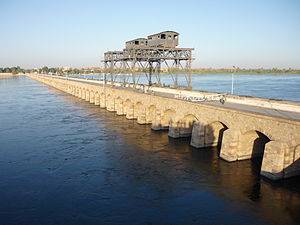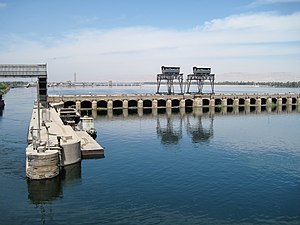Esna weir
| Esna weir Esna Barrage |
|||||||||
|---|---|---|---|---|---|---|---|---|---|
|
|||||||||
|
|
|||||||||
| Coordinates | 25 ° 18 '26 " N , 32 ° 33' 28" E | ||||||||
| Data on the structure | |||||||||
| Lock type: | Gravity dam | ||||||||
| Construction time: | 1906-1908 | ||||||||
| Crown length: | 790 m + 30 m lock structure | ||||||||
| Esna weir with lock; in the background the modern Esna dam | |||||||||
The Esna weir ( Arabic قناطر إسنا, DMG Qanāṭir Isnā , English Esna Barrage ) is a dam over the Nile near Esna in Egypt .
The Esna weir was built between 1906 and 1908 in order to discharge the Nile water from the Aswan dam , which was built a few years earlier and located about 170 km upstream, into the Aṣfūn Canal during the low water period . This canal irrigates the fields to the left of the Nile over a length of 120 km. On the right bank of the river, an even wider canal was built later. The canals were provided with large intake structures for precise regulation.
The 1945-1947 increased Esna dam, used since the construction of 1,990 completed Esna Dam only as a road link, the function of the Aswan barrage was now the Aswan Dam ( Aswan High Dam taken).
description
The Esna weir stands 500 m below the inlet of the Aṣfūn Canal. The gravity dam has a rectilinear ground plan, its dam crest is 874 m long, on the western bank there is an approximately 25 m wide lock structure with a 16 m wide lock chamber and a bascule bridge for the two-lane road running on the dam crest. The foundation plate of the wall is made of granite - stone blocks from Aswan, the pillars of sandstone blocks from the historic quarries of Gebel Silsila with a core of rubble masonry . The wall has 120 bottom outlet gates , each 5 m wide and framed by 2 m thick pillars and served by two large portal cranes on the top of the dam. However, every tenth pillar is 5 m thick, so that there is a long row with groups of ten gates each. The arches of the gates were made of concrete rather than brick because of the poor quality of the clay in the area.
The intake structure for Aṣfūn channel ( English Esna Head regulator ) is in Esna approximately 170 m after the beginning of the channel. It has six inlet gates, each 5 m wide, but no lock. A four-lane road with wide sidewalks leads over the structure.
history
During his rule over Egypt, which lasted from 1805 to 1848, Muhammad Ali Pascha ordered the construction of the Delta Barrages , which were not completed until after his death, but with which the conversion of irrigation methods on the Nile from seasonal irrigation in flood basins to year-round irrigation through canals was initiated.
The khedive (viceroy) Ismail Pasha built the Ibrahimiyya Canal from 1867 to 1873 , primarily to be able to irrigate his sugar cane fields all year round.
After the rehabilitation of the Delta Barrages proved successful, the British began to introduce large-scale year-round canal irrigation. By Nile water was at 1902 finished Aswan dam retained and stored with the first and Assiut Barrage controlled spread between the flow and the ibrahimiya canal. In 1903 the Zifta weir on the Damietta arm in the Nile Delta followed to improve the irrigation of the fields there.
The Esna weir was then the next and the first weir below Aswan. It was designed by Sir Arthur Webb and built by Sir John Aird & Co. under the direction of M. MacDonald between April 1906 and December 1908. It supplied the fields of Qina Province with water and protected them from drought in the years with low water levels.
The Esna weir was strengthened from 1945 to 1947 in order to be able to raise the water level by two meters to 4.5 m.
See also
Web links
Individual evidence
- ^ William Willcocks, James Ireland Craig: Egyptian Irrigation . Volume II. 3rd edition. Spon, London / New York 1913. pp. 668 f
- ↑ Mamdouh Shahin: Hydrology of the Nile Basin. Elsevier, Amsterdam 1985, ISBN 0-444-42433-4 , p. 447 excerpts on Google Books



